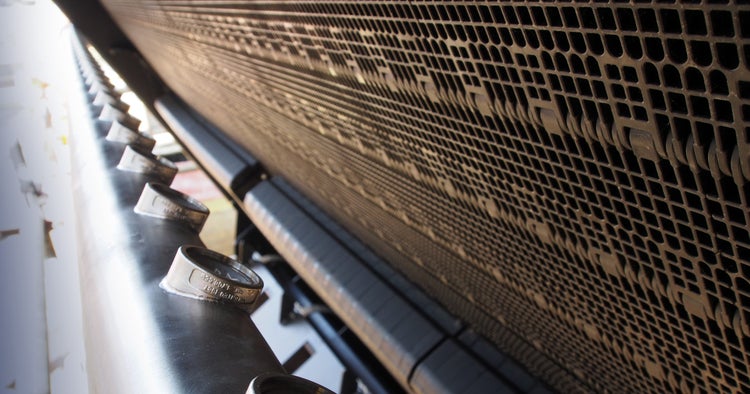Fueling the Nuclear Renaissance
How Hydrolox technology is leading the charge
- Insights
- February 8, 2024

There’s a reason we call chain-driven steel screens a traditional solution.
“The design’s been around for 100 years,” says Brett DeRousse, U.S. National Account Manager for Hydrolox.
In that century, a lot has changed. Environmental regulations, production scales, and even the climate all now demand more from water intake screens.
“I like to say we brought innovation to the industry,�” DeRousse says.
But what difference can a water screen make? Will it really improve safety? Productivity? Your bottom line?
We sat down with our experts to discuss the future of nuclear power and what the next generation of water screen technology is doing for nuclear operations around the world.
Breaking Tradition
“Traditional screens worked well for what they were asked to do, which is basically rotate the screen as infrequently as possible, letting debris pile up on them,” DeRousse says. “Then you rotate the screen to clean it and shut it down again.”
But with Section 316(b) of the Environmental Protection Agency’s Clean Water Act now in effect, water screens must run whenever water is being pulled into the plant’s intake. For most nuclear operations—especially those with cycle cooling systems—that means their screens are running 24/7.
“They’ve gone from operating maybe two or three hours a day to 24 hours a day,” DeRousse says. “They were never designed for that.”
But Hydrolox screens were.
“People do run them intermittently,” DeRousse says. “But our screens are designed to run 24/7 and still outlast steel screens. From what we’re seeing, they’re doing so on the order of 10 times the life of a traditional screen.”
Our screens’ sturdy construction certainly contributes to their incredible lifespan, using non-corrosive engineered polymer mesh bolstered by a durable steel frame. But DeRousse points to our innovative, chainless design as a secret weapon he wishes weren’t so secret.
“Everybody knows us as the engineered polymer screen,” he says. “But I wish they knew us as the chainless screen. We’re the only screen on the market that doesn’t use chains to drive the mesh.”
Chains allow bypass. They elongate. They break. And then to be replaced, the screen has to be shut down and removed from service.
I’m calling it the renaissance of nuclear energy, new nuclear power. And we’re uniquely positioned to address it.
Vice President for Hydrolox
“Eliminating chains eliminated the biggest water screen maintenance issues,” DeRousse continues. “Ask any maintenance tech what their most frequent task is, and it’ll be dealing with chains. They’re expensive, time consuming, and a safety hazard.”
In addition to getting rid of chains, our design also eliminates all serviceable parts below the water line. Hydrolox screens are specifically built for simple operation and maintenance—without removal from the well.
“It is absurd to us that a screen has to be pulled out of the well every three, four, or five years; be sent away; have all the carrier chains replaced; have the guide rails replaced; and maybe have the bearings in the foot shaft replaced,” says Tim Woodrow, Vice President for Hydrolox. “Then you have to sand blast it, repaint it, put it back together, and send it back to the plant? That seems like a really bad idea.”
Considered in terms of cost, this reduction in maintenance adds up quickly.
“Our partners will estimate their yearly screen maintenance cost at something like $50,000 per screen,” DeRousse explains. “Ours is about $2,000 per screen. Now you’re in total cost of ownership territory. If you’ve got between four and eight screens, that becomes a pretty big savings.”
Additionally, once maintenance requirements fall, maintenance operators are free to do other, more valuable work around the plant.
“So it’s not just maintenance,” DeRousse says. “We’ll also make your plant run more efficiently.”
A New World
More efficiency is always better on its face. But as waters change and intake environments become harsher, this reduction of in-water cleaning labor and increase in screen resiliency are more important than ever.
“Some of these plants were built in the 1960s,” DeRousse says. “Maybe they used to see passing grass every now and then, and of course the spring and autumn leaves, but it’s different now.”
Success Spotlight: Tennessee Valley Authority (TVA)
The Hydrolox Team recently completed an installation of 18 traveling water screens for the Tennessee Valley Authority (TVA).
As temperatures have risen globally, the waters themselves have changed and new species have been introduced to a once-familiar intake environment. And while the environment has experienced a century’s worth of change, chain-driven steel screens have stayed the same.
It’s not a good combination.
“Ever increasingly strong storms are inviting grasses, algae, and debris that traditional screens aren’t equipped to handle,” DeRousse says. “They’re coming into intakes and just wreaking havoc on these plants.”
For coastal facilities, the threats brought on by the changing environment are large jellyfish swarms.
“Overseas and especially in the Middle East, with the warming of the oceans, the amount of jellyfish prevalent in intakes has dramatically increased in recent years,” DeRousse says. “These intrusions have even begun shutting down nuclear power plants here in the U.S. It’s a dangerous situation.”
“These jelly blooms are huge,” Woodrow adds. “There can be hundreds of thousands of jellyfish—maybe even millions—in these swarms. They get drawn into the intake. They knock out screens. Then the plant shuts down and maintenance crews have to scram the reactor. That’s a very bad day in the office for a nuclear power plant.”
But unlike traditional screens, the Hydrolox engineered polymer screen mesh rides directly atop a chevron-patterned stainless steel carryway. This innovative design transfers the force through the mesh directly to the equipment frame allowing it to bear the brunt of extreme loads.
“Our solution is significantly better at offering safety and reliability,” DeRousse says. “We don't collapse or crash like a traditional screen does. We can handle more debris and we have a much, much more robust solution than a traditional screen, which in the nuclear world is paramount. If they can't get cooling water into the plant, that becomes a major operations issue.”�
“Hydrolox screens can just withstand huge amounts of force that other screens can’t,” Woodrow says. “In the nuclear industry in particular, we’ve really raised the bar for safety. They no longer view their traveling water screen assets as a maintenance burden, but as a reliable piece of equipment.”
In fact, one nuclear power plant that uses Hydrolox technology has surpassed 800,000 hours of runtime across their fleet—with zero unscheduled downtime.
“There’s no other screen on the market that could get close to that,” Woodrow says.
Download the industry highlight
Want to learn more about the Hydrolox design features changing the nuclear industry’s expectations of their water screen technology?
The Renaissance of Nuclear Energy
“Engineered polymer is the future,” Woodrow says. “We can build screens to any width. We can design an entire intake in 50 meters versus 70 or 75.”
“We can dramatically reduce the water intake structures at nuclear plants using drum screens or other traditional technology,” says Gianluca Genchi, Global Business Development Manager for Hydrolox. “The bigger the plant, the bigger the intake, the more savings we can offer because our screens can go wider.”
In addition to our design’s inherent strength and safety, our screens are custom-designed to meet the civil needs of our individual partners. This is a huge benefit when, say, building a new plant from the ground up.
“The industrial leaders of the world just committed to tripling nuclear energy production by 2050,” Woodrow says.
He’s referring to the announcement at COP28, at which more than 20 countries agreed to what they called the Declaration to Triple Nuclear Energy.
“There are currently a little over 400 nuclear reactors in operation in the world,” Woodrow says. “This pledge means approximately 800 new reactors could be built in the next 25 years.
“I’m calling it the renaissance of nuclear energy, new nuclear power,” Woodrow continues. “And we’re uniquely positioned to address it.”
And it’s not simply that we can save on civil costs. Our screens are so good at preventing bypass, we’ve gotten reports from nuclear partners that their condensers perform better.
“Our screens seal completely at the sides and prevent all bypass at the boot section,” DeRousse says. “Because we’ve eliminated all carrier chains, there’s no way for debris to get under or around them. One of our partners found that their condenser’s heat rate improved so much as a result of its cleanliness; they were producing almost 1% more energy. The economic value of that is incredible.”
It’s also the whole point of pursuing nuclear energy as a clean alternative to fossil fuels.
“If you’re using less heat to produce the same amount of energy or more, that’s an environmental win,” DeRousse says. “You’re an eco-friendlier operation.”
Every technology in your life has gotten better…Why wouldn�’t traveling water screens have gotten better, too?
U.S. National Account Manager for Hydrolox
The Best in Any Industry
Whether it’s because they’re close to failure or they don’t comply with Section 316(b), you’ll have to change your old chain-driven steel screens—soon. And when you do, you have a choice.
“These screens that are in your plant have been there for 30 years,” DeRousse says. “And they’ve been a problem for 30 years. This is essentially a once-in-a-lifetime chance to improve your intake. Do you put the same technology in that’s had problems at a 20% run rate and expect it to be great at a 100% run rate?
“Every technology in your life has gotten better,” DeRousse continues. “Your cell phone went from a flip phone to what we have now in the blink of an eye. Why wouldn't traveling water screens have gotten better, too?”
When searching for better water screen technology, you’ll only find one designed to run in water 24/7 with virtually no maintenance, to eliminate bypass and corrosion, and to withstand the extreme forces of our changing waters.
“I think we’ve raised the bar so high there’s not much to keep up with,” Woodrow says. “Screens no longer have to be seen as a maintenance burden, but rather as a revenue generating asset. That’s quite a turnaround in a short period of time.”



